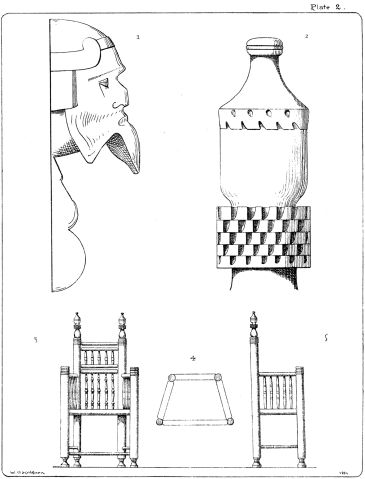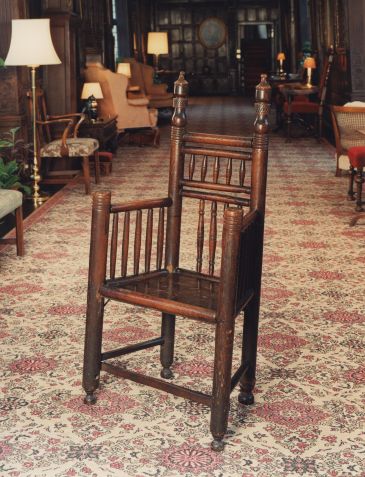This is probably an early 16th century chair, and so of the same historical period as that when Erasmus of Rotterdam stayed in Queens’ College.
However, we can offer no evidence as to (a) whether Erasmus himself ever used this chair, (b) how the name of the chair might have originated, (c) when the chair arrived in college. Nothing of its provenance or history is recorded. The chair is an example of a design known as a Board-seated Turned Chair.
The primary wood is ash, and that is highly unusual among such English chairs, most of which are made of elm or yew. The turnings are severely plain compared to those of Welsh chairs, and they relate closely to those displayed by Dutch chairs illustrated in sixteenth- and seventeenth-century paintings and prints. What’s more, the turnings are devoid of the mannerist motifs seen on most Welsh chairs. The towering finials are picked out with systematic gougework that almost never appears in Welsh chairs. … It has suffered a number of losses. The feet were extended 2½ inches (6.35 cm) during the late seventeenth century. The front stretcher, six associated spindles above it, the rear stretcher, and one back spindle are gone. The seat board is a softwood replacement. A later top rail has been added to the back. Iron braces have been added under the seat.
[Trent, 1990, p. 47]
Great chair, probably London or Cambridge, England, 1510–1514. Ash and pine. H. 49″, W. 24⅝″, D. 17″. The seat rails have a large rectangular tenon at one end and a small round tenon at the other. The upper back rail is an addition, the front stretcher is replaced, the feet have been pieced out, and the rear stretcher and six spindles under the front seat rail are missing.
[Trent & Alexander, 2007, fig. 31]
It has been described to be as fine a turned chair as exists in Europe.
[by Frank Davis, in Illustrated London News, 1934 Dec 15, p. 1026]
 These drawings, dated 1880, were first published in 1886 as Plate 2 of Ancient Wood and Iron Work in Cambridge, by William Beales Redfarn. The original descriptive text, by John Willis Clark, reads:
These drawings, dated 1880, were first published in 1886 as Plate 2 of Ancient Wood and Iron Work in Cambridge, by William Beales Redfarn. The original descriptive text, by John Willis Clark, reads:
The old chair, given on Plate II, now in the President’s Lodge in Queen’s College, is connected by tradition with the name of Erasmus. He is known to have resided in Queen’s College in 1510 and 1511; and is said to have lodged in the south-western turret of the great court. The little court, out of which stairs leading to that turret rise, is sometimes called Erasmus’ Court; and the avenue of trees on the common behind the College, along the south side of King’s College Ditch, has been called Erasmus’ Walk from time immemorial. It was, however, not planted until 1685, and the connection of it with the great scholar is therefore as apocryphal, as in all probability that of the chair is, through that undoubtedly dates back to the time of Erasmus. No. 2 is a drawing, of the exact size of original, of one of the tops of the back of the chair; Nos. 3 and 5, give the front elevation and a side view of the chair; and No. 4, the plan of the seat. These are drawn to the scale of 1 inch to the foot.
[Drawing No. 1 of Plate 2 is unrelated to the chair: it is a side view of one the carved heads above the linen-fold panelling in the President’s Study.]
Further Reading
1886: Ancient Wood and Iron Work in Cambridge, by William Beales Redfarn, letterpress by John Willis Clark, plate II. (OCLC 11373488)
1934: The Turned Chair Problem: II — Chairs with four legs, by Frank Davis, in Illustrated London News, 1934 Dec 15, p. 1026. (ISSN 0019-2422)
1949: The President’s Lodge, Queens’ College Cambridge, in The Antique Collector, Vol. 20, No. 3 (May–June 1949), pp. 69–76. (ISSN 0003-5858)
1990: The Board-Seated Turned Chairs Project, by Robert F. Trent, in Regional Furniture, IV (1990), pp. 42–48, Fig. 3. (ISSN 0953-0800)
2007: American Board-Seated Turned Chairs, 1640–1740, by Robert F. Trent and John David Alexander, in American Furniture 2007, ed. Luke Beckerdite. (ISSN 1069-4188, ISBN 978-0-9767344-1-3)
